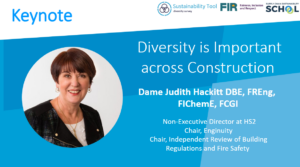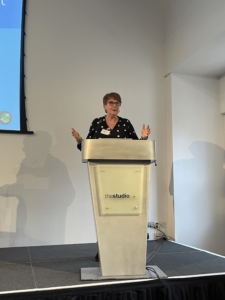
On the 12th of December 2023 the Fairness, Inclusion and Respect programme held the 2023 Diversity Data Benchmarking Conference where we explored and looked at the data from our annual Diversity Survey, already the largest built environment sector data capture exercise and continuing to grow. The 2023 Survey represents data on over 526,000 employees from 537 companies – 382 of which are SMEs with the remainder comprising large organisations operating in the built environment sector.
One of the highlights of the Conference was the insightful keynote delivered by Dame Judith Hackitt, where she addressed the importance of diversity in the built environment. Dame Judith highlighted her personal connection to diversity and inclusion, emphasising the need to break down barriers for individuals pursuing their chosen paths, as well as the need for our built environment to cater to all people who use it.
Dame Judith’s full keynote address is published below.
—
Thank you and good morning, it’s a real pleasure to be here, standing here, looking out on this very Diverse audience. Believe me if you go back over my career the number of times I’ve stood on platforms and talked to all-white males has been more often than I care to think about.
I have been asked me to talk about why diversity is important in the construction and infrastructure sector. Diversity is actually important in every sector. There should be no barriers to anyone working anywhere. We should all be free to choose our chosen path and be given the opportunity to demonstrate our full potential.
Diversity & Inclusion is very close my heart – it is personal. I decided I wanted to be an engineer back in the 1970s. I cannot tell you how many people tried to persuade me other-wise and told me I couldn’t do it. I fought to prove them wrong, but I shouldn’t have had to do that, and I often wonder how many other girls back then were talked out of what they really wanted to do. I suspect too that many boys were also talked out of roles they wanted to do if they didn’t fit the stereotype.
I am proud to be the diversity champion on the HS2 board and I am proud of what we have achieved and what we lead on. Our most recent stats show that across the organisation we have 39% females and 29% ethnic minorities. Because we also set expectations for our supply chain we’re seeing a change there too – 30% women and 20% ethnic minorities.
All significantly above industry average for construction and infrastructure.
None of this happens by accident. It comes from working hard to attract and encourage people to join us. By offering work experience to young people to join us which changes their perception of the industry; by offering a job brokerage service; by offering job starts to those who are out of work and long term unemployed; and by having an apprenticeship programme which targets under-represented groups and those who are disadvantaged in the labour market.
Our equality, diversity and inclusion expectations for our supply chain providers are part of our contractual requirements, not just a nice thing to do. Many of our supply chain are now externally accredited in diversity and inclusion which is great.
At HS2 we continue to live out our values by leading EDI. We are driving the industry culture change and we have recently had our clear assured platinum status re-confirmed.
Some of you may have read a recent interview I did for Rail Industry magazine where I explained not only what we were doing in HS2 but why we were doing it.
First and foremost, we have a shortage of skilled and talented people. We need to attract more people into the infrastructure sector – we cannot afford to exclude large swathes of talent out there who assume that this sector is not for them, or worse still, that we wouldn’t what them. It’s just common sense for us all to work together to increase the size of the pool of talent we are all fishing in.

But it’s also important because of what we do. The infrastructure we create has a purpose and that is to improve the lives and experience of everyone in the communities we serve. To do that, our workforce needs to reflect the diversity of those communities – mothers travelling with children, the elderly, those who are visually impaired or hard of hearing, those who feel vulnerable or different, they all use the infrastructure we create. If we have a workforce that truly understands how they feel and what their needs are then we will deliver better outcomes.
At this point I just want to take a few minutes to reflect on another real-life aspect of what I encountered when I conducted my building safety review that you will have seen and that I am sure many of you will have heard about after Grenfell tower disaster. I was shocked by the lack of connection between those who were responsible for the building construction and the occupations – with the purpose of what they were delivering – the need for them to deliver safe homes for people to live in. I also encountered bias/prejudice with respect to the different communities – dependent upon whether buildings were for private sale or rent and whether or not the buildings were intended for social housing for disadvantaged individuals and families. Assumptions about the worth of the people for whom we provide solutions have no place in our industry.
Fairness, inclusion and respect is not just about those we employ but also those we serve. The more we embrace Diversity and inclusion internally the better we will do in our business outcomes and our reputation. However, there is still a long way to go.
There is a lot of good practice to share among ourselves but there is also a wealth of good practice in other industry sectors which we need to explore and learn from. We will see some of that comparative data during the course of today and we all need to commit to go looking for, and seeking to transfer, that learning into this sector. All too often, we have a tendency to put the blinkers on and rationalise why we’re different or ‘special.’ That creates barriers in our minds as to why what they did won’t work for us. It will, it is applicable if we’re smart and open to change.
I am really looking forward to today as I am sure you are. We have already seen some fascinating data which of course need further exploration. But today isn’t just about us all seeing that data and reflecting on where our organisations fit in that. The real purpose of today if it is to be useful for all of us is for us all commit to leave this event today committed to do even more in EDI in construction and infrastructure. I know that’s what I intend to do.
Thank you.
—
We would like to extend a big thank you to Dame Judith Hackitt for attending the conference and for her strong message about the relevance of diversity in both driving better sector outcomes and understanding the needs of the community who use the built environment .
Please click on the links if you would like to learn more about our Diversity Survey and the Fairness, Inclusion & Respect Programme.
